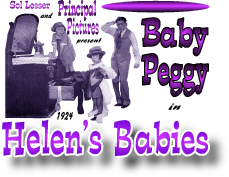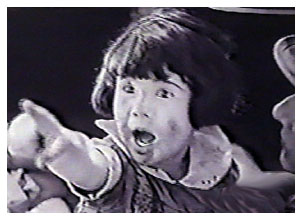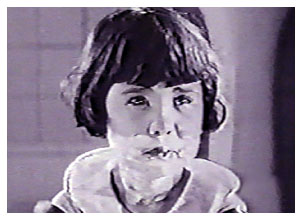

Principal Pictures
Cast: Baby Peggy (Toodie), Edward Everett Horton (Uncle Harry), Clara Bow (Alice Mayton), Jeanne Carpenter (Budge), Claire Adams (Helen Lawrence), Richard Tucker (Tom Lawrence)
Tom and Helen Lawrence have followed the book "How
to Rear Children" by Harry Burton religiously in bringing
up their two little girls, Toodie and Budge. Coincidentally, Harry
is Helen's brother. When the couple receives a letter that Harry
is coming for a visit and to get some rest, they figure this is
the perfect time to take a weekend vacation. After all, Uncle
Harry will there, and he's an expert on raising children. What
they don't know is that he only wrote the book because a publisher
said it would sell. A title tells us, " . . . and since then
(he) has been dodging questions about kids to which he doesn't
know the answers." As Harry disembarks from the train, to
his surprise, Tom and Helen board the train with thanks for looking
after the children while they're gone. The children almost drive
the timid Harry crazy climbing trees, walking on the roof of the
house, nearly  destroying his trunk
full of clothes and other belongings, getting mixed up with a
band of gypsies and nearly getting run over by a train. Mixed
into all of this is the romantic interest of lovely neighbor Alice
Mayton that Harry is slow in realizing. Will Harry - and the children
-- survive until Tom and Helen return?
destroying his trunk
full of clothes and other belongings, getting mixed up with a
band of gypsies and nearly getting run over by a train. Mixed
into all of this is the romantic interest of lovely neighbor Alice
Mayton that Harry is slow in realizing. Will Harry - and the children
-- survive until Tom and Helen return?
"Helen's Babies" is not a great film, nor does it contain memorable gags that would be recounted in silent film histories, but it is an enjoyable film to watch and a good example of fairly standard fare for the day.
There is no lack of talent involved with this film. Although Sol Lesser and his production company, Principal Pictures, aren't remembered for any of the "big" photoplays, the film was directed by William A. Seiter who later directed many of the best films of such stars as Reginald Denny and Colleen Moore, and it was photographed by William Daniels who photographed several Greta Garbo films and is considered to be her favorite cameraman.
The film, however, belongs to Baby Peggy and Edward Everett Horton. Relative unknowns Claire Adams and Richard Tucker portray the parents, Tom and Helen, and have negligible screen time. Baby Peggy is obviously given the lead role over Jeanne Carpenter who played her sister, Budge. After a few minutes of screen time, it's obvious why. Carpenter is charming, but she's doesn't nearly possess the talent of Baby Peggy.
The film basically lays out a series of misadventures during a weekend of babysitting for the timid Harry Burton. The scene is set - and we almost know what's about to take place - when Helen receives a letter from her brother about his impending visit. It's especially prescient when he adds, "I need a rest. I'm coming down to get it."
Once Tom and Helen leave on the train, Harry is escorted home by the pretty young neighbor, Alice. It's obvious as the two sit in the back seat of the open car that Harry is shy and maintains a safe distance from this intimidating member of the opposite sex.
As they near the house out in the country, they look ahead to see Toodie dangling from a tree limb. She had thrown her doll in the air, and it became stuck in the tree. When she climbed up to get it, she slipped and is now hanging onto a small limb high above the ground. They pull the car under the tree, and Toodie drops into the back seat between Harry and Alice. (This entire scene was actually filmed with Baby Peggy up in a real tree outdoors - see the accompanying comments by Diana Serra Cary on the film) Harry is content to take the two girls and go on to the house, but Toodie insists they must get the doll out of the tree. Of course, the less than agile Harry must awkwardly make his way up the tree and out on the limb, but when he steps on a small limb, he comes crashing to the ground. Fearlessly, Toodie shimmies back up the tree and gets her doll. As she stands on the limb looking down at Harry, she announces, much to his horror, "I'm a bird. Watch me fly!" and jumps into his arms.
This is just the beginning for Harry as the girls continue to terrorize him throughout the weekend. For example, back at the house, they offer to help him unpack his trunk, and, before long, the room and all of Harry's belongings are a shambles. One of the cutest scenes involves a round box full of starched collars. Of course, they are rolled tight in order to fit into the box, but, once Toodie pulls them out, she finds that getting them back in is not so easy. It's an adorable scene with her sitting on the floor, rolling the collars back up and holding them together any way she can, including between her knees! Finally, in frustration, she stuffs them into the box as well as possible - with most of them hanging out - puts the lid on, and then proceeds to stomp the box shut. Harry is so exasperated by it all, he leaves for a walk and doesn't come back until after the girls' bedtime. What he doesn't realize is that they are waiting for him to enact their usual nightly routine of prayers, a glass of water and a final "God bless you!" before they'll go to sleep.
As a credit to both the direction of Seiter and the acting
of the children, for some reason, all of this comes across more
as ineptitude on the children's part rather than brattiness. Their
intent is not to annoy Uncle Harry, but to help him. It's just
that they are children imbued with more exuberance than skill.
As a matter of fact, they  love
Uncle Harry dearly and are constantly hugging and kissing him.
Unfortunately, he's not receptive to this affection - obviously
never having experienced it before - and just wants to be left
alone in his room with his books.
love
Uncle Harry dearly and are constantly hugging and kissing him.
Unfortunately, he's not receptive to this affection - obviously
never having experienced it before - and just wants to be left
alone in his room with his books.
The next morning, the girls go to wake Uncle Harry, but his door is locked. Undeterred, Toodie ventures out of her bedroom window, walks along the ledge of the roof, and goes in Uncle Harry's bedroom window. When he awakes, the first sight he sees are two children grinning broadly at him -- one wrapped around each of the bedposts announcing, "Uncle Harry! It's after six o'clock!"
Baby Peggy had one of the most expressive faces on the silent screen and could register surprise with pursed lips, raised eyebrows and eyes that lit up like flares - or she would tilt her head with a dimpled smile that would warm the coldest heart. Her comedic talents were natural and right on target, but she could also elicit sympathy and shed tears with the best of them (see "Captain January" if you want a good tug at the heart strings). In one scene in "Helen's Babies," she is given the opportunity to show us what she can do.
Uncle Harry has been shaving in the bathroom, and Toodie has been watching surreptitiously. When he leaves, she climbs up on a stool at the sink, uses his brush to lather her face, and, to our horror, she picks up his straight razor. The camera cuts to Harry in the bedroom, who jumps as he is obviously startled by something. He runs into the bathroom, and there is Toodie, sitting on the floor, leaning back against the base of the sink, with the razor held high in her right hand. "I slipped, but I didn't break the knife," she says proudly. Of course, this is humorous, but Harry stoops down in front of her with finger wagging, justifiably upbraiding her for her foolishness. Seiter then moves the camera in for a close up of the little cherub face, all covered in shaving lather, as she begins to tear up and cry. "I always try to do right, but everything I do is wrong." What a splendid moment! The viewer is touched by the tenderness of the scene, and who couldn't be moved by that little lathered face with tears streaming down the cheeks? Unfortunately, Seiter doesn't develop this insecurity of Toodie's any further. It's a one-shot deal with nothing taking place before to offer a basis for her concern nor any follow-up on it later in the film. How much deeper could the film have taken the child's character if this had been pursued and possibly have Uncle Harry help Toodie overcome her "everything I do is wrong" angst.
The climax of the film is a fairly rousing one as the girls wander off chasing a stray dog. They end up in a gypsy camp leading Harry and Alice to later believe the gypsies kidnapped them. Then, they wander onto a train track with a speeding train bearing down on them. All ends well, though. Of course, Harry's ineptitude with children is exposed, but his love for the two girls has now been established as a result of their adventures - plus, Harry knows a lot more about rearing children than he ever did.
As noted, "Helen's Babies" is a very enjoyable film to watch, but, like many other films, it has so much potential that is never fully realized. For example, the children's characters are never developed other than to show them as constantly getting into predicaments. The mishap in the bathroom with the shaving razor was mentioned, and Toodie's comment, "I always try to do right, but everything I do is wrong," is a good example of how the audience could have been involved more emotionally in the children's lives. They obviously love Uncle Harry, but there is never any time where they get to know each other.
Possibly the most frustrating relationship is between Harry
and Alice. Although this was early in Bow's career (she was only
19 years old), we know from the amazing talent she displayed in
the ensuing years that she could have risen to whatever challenge
she was given, but the role of Alice doesn't offer her that opportunity.
We  know she is interested in Harry
- that is shown when they first get in the car together. In a
later scene, Harry leaves the house to go for a walk, and Alice
is next door at her mailbox. He looks her way and then goes off
walking in the other direction as she watches him with hurt in
her eyes. The viewer is puzzled why he would do that. The next
day she comes by the house in her car and asks him to go for a
ride. He declines but does accept an invitation to come over with
the children and have Sunday dinner with Alice and her mother.
Why did he decline the drive in the country? If he's so shy, why
did he accept the dinner invitation - and also prepare flowers
to give her? Never in the film is there adequate screen time for
just the two of them to interact without the children around so
this relationship can develop some depth and reason.
know she is interested in Harry
- that is shown when they first get in the car together. In a
later scene, Harry leaves the house to go for a walk, and Alice
is next door at her mailbox. He looks her way and then goes off
walking in the other direction as she watches him with hurt in
her eyes. The viewer is puzzled why he would do that. The next
day she comes by the house in her car and asks him to go for a
ride. He declines but does accept an invitation to come over with
the children and have Sunday dinner with Alice and her mother.
Why did he decline the drive in the country? If he's so shy, why
did he accept the dinner invitation - and also prepare flowers
to give her? Never in the film is there adequate screen time for
just the two of them to interact without the children around so
this relationship can develop some depth and reason.
Those who know Horton from the sound films of the 1930's and afterward have no doubts about his comedic talents. As Diana Serra Cary noted, "He went right into talkies from the silent era and wasn't afraid of them at all. He was one of those reliable comedy relief men, and he was better in talkies than ever before -- because he had stage delivery, he had timing - he knew the whole thing." Horton also had the face of a comedian, and he comes across well in "Helen's Babies" as he expresses frustration, anger and even shyness. The classic Horton look can be seen when he thinks he's giving Bow a box of flowers, and she opens the box only to find Toodie's beat up, homemade baby doll. He first registers puzzlement and then the embarrassed grin that registered so well on his sharp face.
"Helen's Babies" by John Habberton and was originally published in 1876. It remained popular enough to be chosen for a Baby Peggy vehicle although it was obviously updated to modern (1920's) times. The transference of a book to the screen takes a skilled scenarist, and adapting Habberton's book to the screen was the team of Hope Loring and Louis B. Lighton. They were relatively new (Loring three years, Lighton one year) to the movies with no major films to their credit, but they later did the scenarios for "Little Annie Rooney" (1925) with Mary Pickford and "Wings" (1927) with Buddy Rogers and Clara Bow. As noted before, cameraman William Daniels and director William Seiter were significant talents, too.
It is unfortunate that no one has chosen to release any of Baby Peggy's films on DVD at this time. At least four of her features survive in very good condition: "The Family Secret" (1924), "Captain January" (1924), "Helen's Babies" (1924), and "April Fool" (1926). All of these have been distributed at one time or another on VHS by various companies with "pieced together" music scores. Sadly, although it is estimated she made over 100 short comedies for the Century studios prior to these feature films, only a handful survive.
"Helen's Babies" is another example of her extraordinary talent, even when given limited material with which to work. The Century comedies that survive show what a talented child this was, and the fan magazines and other publications of the period attest to her astounding popularity which was surpassed only by Jackie Coogan. It's time to broaden her exposure with some clean copies of her work accompanied by specially written music scores. In the meantime, don't pass up a chance to see "Helen's Babies" or any of her other films.
Copyright 2006 by Tim Lussier. All rights reserved.